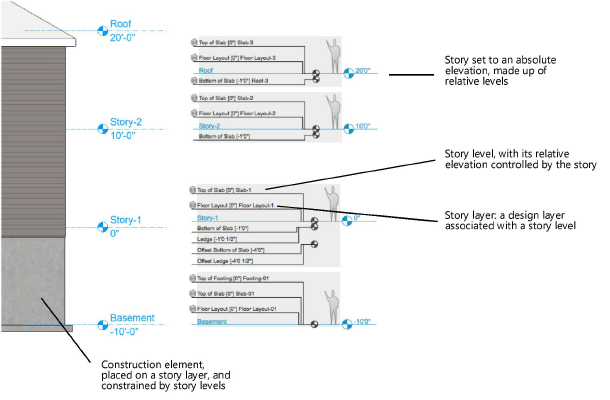 Setting up the building structure with stories
Setting up the building structure with stories
Vectorworks uses layers and classes as a way of organizing the drawing. Vectorworks Architect includes an additional file structuring feature called stories, which define the absolute elevations for the various floors of a building. Stories allow designers to manage defined levels within those floors to control construction elements, like slabs and walls, on the design layers associated with those levels. Vectorworks Landmark also includes access to the stories feature, to help landscape architects collaborate with architects.
While layers are a great organizational tool for drawings, stories allow a finer level of control. A single story can automatically control the heights of multiple levels with associated layers and objects, as well as the relative heights of all other stories. This makes stories highly useful for complex, multi-floor models. For certain types of file format exchanges such as IFC, stories are the recognized standard.

Several interdependent drawing elements allow you to automatically manage and update the elevations of design layers and the objects they contain as the design evolves.
Stories define the absolute elevations for the floors of a building. Although stories provide the means to manage and automatically adjust the elevations of associated levels, layers, and objects, they cannot contain drawing objects.
Story levels associated with each story are assigned an appropriate level type (a short name that describes what the story level represents) and an elevation relative to the story. Typically, each story has multiple levels, such as a "Slab" level type with a 0" offset from the story, and a "Ceiling" level type with a 9' offset from the story. If needed, you can create more detailed levels such as "Top of Slab" and "Bottom of slab," each with the appropriate offset. The story controls the absolute elevation of the levels. If the story elevation changes, the associated levels and design layers automatically change their elevation or boundaries along with the story.
Story layers are normal design layers that have been associated with a story. Story layers can contain objects (such as walls, slabs, furniture, and fixtures); to control objects by story elevation, at least one layer associated with a story is required. Each story can be associated with multiple design layers, but each story level type can be associated with only one design layer per story.
Construction elements that can be story aware include slabs, walls, wall components, curtain walls, spaces, stairs, escalators, and columns. A story's levels can act as a top and/or bottom constraint for these special bounded objects, so they can automatically take on the correct height. The dynamic height information can be saved in wall, slab, and space styles. For example, an exterior wall (or one of its components) can extend from the slab on one story to the slab on the story above it. The location of the objects’ boundaries is controlled by the elevation of the level and ultimately by the story elevation.
In addition to the special bounded objects, symbol insertion points can also be story aware. As enabled in the symbol definition, the symbol elevation can be automatically set to the level. Symbol instances can be set to a different level from the Object Info palette.
Using stories, story levels, story layers, and bounded objects allows flexibility and accuracy when defining a model, from the initial setup to the final stages of design.
